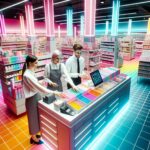Question 1:
What is a key benefit of implementing a mobile-first design for e-commerce websites?
- A) Increases website loading time
- B) Enhances desktop browsing experience
- C) Improves user experience on mobile devices
- D) Reduces the need for responsive design
Answer: C) Improves user experience on mobile devices
Question 2:
Which technology is used to offer personalized shopping experiences through data analysis?
- A) Blockchain
- B) Augmented Reality (AR)
- C) Machine Learning (ML)
- D) 5G Connectivity
Answer: C) Machine Learning (ML)
Question 3:
How does augmented reality (AR) enhance the online shopping experience?
- A) By providing faster payment options
- B) By allowing customers to visualize products in their own space
- C) By reducing the need for customer service
- D) By increasing website loading times
Answer: B) By allowing customers to visualize products in their own space
Question 4:
What is a major trend in mobile payments?
- A) Decrease in contactless payment options
- B) Rise of mobile wallets and contactless payments
- C) Increased use of cash on delivery
- D) Decline in online shopping
Answer: B) Rise of mobile wallets and contactless payments
Question 5:
Which of the following is NOT a typical feature of mobile SEO?
- A) Optimizing for voice search
- B) Using large, uncompressed images to improve quality
- C) Local search optimization
- D) Mobile-friendly site structure and design
Answer: B) Using large, uncompressed images to improve quality
Question 6:
What challenge do businesses face when implementing mobile payment solutions?
- A) Lack of customer interest in mobile payments
- B) Technical integration with existing systems
- C) Overabundance of identical payment platforms
- D) Decreased security and increased fraud risk
Answer: B) Technical integration with existing systems
Question 7:
Which emerging technology promises faster data speeds and improved connectivity for m-commerce?
- A) 3G
- B) Bluetooth
- C) 5G
- D) Wi-Fi 6
Answer: C) 5G
Question 8:
What role does blockchain technology play in m-commerce?
- A) Decreasing mobile internet speeds
- B) Enhancing product visualization with AR
- C) Securing transactions and reducing fraud
- D) Personalizing marketing content
Answer: C) Securing transactions and reducing fraud
Question 9:
Social commerce is a trend where e-commerce transactions are facilitated directly through:
- A) Email newsletters
- B) Social media platforms
- C) Print advertisements
- D) Television commercials
Answer: B) Social media platforms
Question 10:
Voice commerce allows consumers to:
- A) Print receipts using voice commands
- B) Make purchases using voice assistants
- C) Listen to product descriptions in multiple languages
- D) Increase the volume of their device
Answer: B) Make purchases using voice assistants
Short-Answer Questions: Applying M-commerce Concepts
Question 1
Your e-commerce company is planning to enhance its mobile app to improve customer engagement. What machine learning feature could you integrate to personalize the shopping experience for users, and how would it work?
Question 2
A fashion retailer wants to use augmented reality (AR) in their mobile app to reduce return rates. Describe an AR feature they could implement and explain how it might help achieve this goal.
Question 3
Considering the rising trend of voice commerce, how can an online grocery store optimize its mobile platform to support shopping via voice assistants? Provide one specific strategy.
Question 4
Your company has noticed a significant drop in mobile sales conversions due to lengthy checkout processes. What mobile payment solution could you implement to simplify and secure transactions, and what impact would you expect it to have on conversion rates?
Question 5
A furniture e-commerce brand is expanding its mobile marketing strategy to include social commerce. Describe how they could leverage Instagram to drive sales directly from the social media platform.
Sample Answers
Answer 1
One machine learning feature we could integrate is a personalized recommendation system.
By analyzing past purchase history, browsing behavior, and user preferences, the system could suggest products that match the user’s taste.
For example, if a user frequently browses outdoor gear, the app could highlight new camping equipment or recommend popular hiking apparel, thereby making the shopping experience more relevant and engaging for each user.
Answer 2
The fashion retailer could implement a “Virtual Try-On” AR feature, allowing customers to see how clothes look on them using their smartphone’s camera.
This feature helps customers visualize the fit, style, and color of the clothing on their own body, reducing the uncertainty that often leads to returns.
By providing a more accurate sense of how a garment fits, customers are more likely to be satisfied with their purchases, thereby reducing return rates.
Answer 3
To optimize for voice commerce, the online grocery store could implement natural language processing (NLP) to better understand and process voice search queries.
A specific strategy could be to optimize product descriptions and categories for common spoken language patterns and grocery-related queries.
For instance, enabling voice commands like “Add organic apples to my cart” or “What’s on sale in the dairy section?” would make shopping more intuitive and efficient for customers using voice assistants.
Answer 4
To streamline the checkout process, we could implement a one-click payment solution using mobile wallets like Apple Pay or Google Pay.
These solutions store users’ payment information securely and allow transactions to be completed with a single tap, bypassing the need to enter card details manually.
By simplifying the payment process, we would likely see an increase in conversion rates as customers experience a quicker and more frictionless checkout.
Answer 5
To leverage Instagram for social commerce, the furniture brand could create shoppable posts and stories that feature their products in beautifully designed interiors.
By tagging products in these visuals, users can tap items to view product details, prices, and a direct link to purchase the item on the e-commerce platform, all without leaving Instagram.
This strategy not only showcases the brand’s aesthetic but also capitalizes on impulse buying tendencies, driving direct sales from the platform.
Group Project Presentation: AR Shopping Experience for “StyleFit” Fashion App
Introduction
- Project Overview: Our team focused on developing an augmented reality (AR) shopping experience for “StyleFit,” a mobile fashion app. The goal is to leverage AR technology to enhance customer engagement, improve product visualization, and ultimately reduce return rates due to sizing issues.
AR Feature Concept: Virtual Dressing Room
- Description: The Virtual Dressing Room feature allows users to try on clothes virtually using their smartphone camera. By selecting items from StyleFit’s catalog, users can see how different clothing items look on their own body in real-time, from various angles.
- Objectives:
- Enhance Product Discovery: Make the online shopping experience interactive and fun, encouraging users to explore more products.
- Improve Purchase Confidence: Allow customers to visualize how clothes fit and look on their body, increasing confidence in purchase decisions.
- Reduce Return Rates: Address common reasons for returns, such as fit and style discrepancies, by providing a more accurate sense of how garments look and fit.
Technical Implementation
- AR Technology: Utilize ARKit (for iOS) and ARCore (for Android) to develop the Virtual Dressing Room feature, ensuring a wide range of device compatibility.
- User Interface: Design an intuitive UI that guides users through the process of selecting items to try on, positioning themselves within the frame, and viewing different outfits.
- Integration: Seamlessly integrate the AR feature within the StyleFit app, ensuring it complements the existing shopping journey without disrupting user flow.
Marketing and Launch Strategy
- Promotional Campaign: Launch a multi-channel marketing campaign highlighting the Virtual Dressing Room feature, including social media teasers, influencer partnerships, and email marketing to existing customers.
- User Education: Create tutorial videos and in-app guides to educate users on how to use the AR feature effectively, emphasizing its benefits.
- Feedback Loop: Implement a feedback mechanism within the app to collect user insights on the AR experience, allowing for continuous improvement based on customer input.
Impact Assessment
- Engagement Metrics: Monitor user engagement with the AR feature, tracking metrics such as usage frequency, session duration, and conversion rates from AR sessions.
- Customer Satisfaction: Conduct surveys to assess customer satisfaction with the AR shopping experience and its influence on their shopping behavior.
- Return Rate Analysis: Compare return rates before and after the implementation of the Virtual Dressing Room to evaluate its effectiveness in reducing returns.
The Virtual Dressing Room feature represents a significant advancement in how consumers shop for fashion online.
By leveraging AR technology, StyleFit can offer a more engaging, confident, and satisfying shopping experience, setting a new standard in the fashion e-commerce space.
Next Steps
- Finalize development and conduct extensive user testing to refine the AR experience.
- Launch the feature with a targeted promotional campaign to generate excitement and adoption.
- Analyze performance data and customer feedback to iterate and enhance the AR feature over time.
This presentation showcases our team’s innovative approach to integrating AR technology in m-commerce, demonstrating a deep understanding of its potential to transform the online shopping experience for the better.













